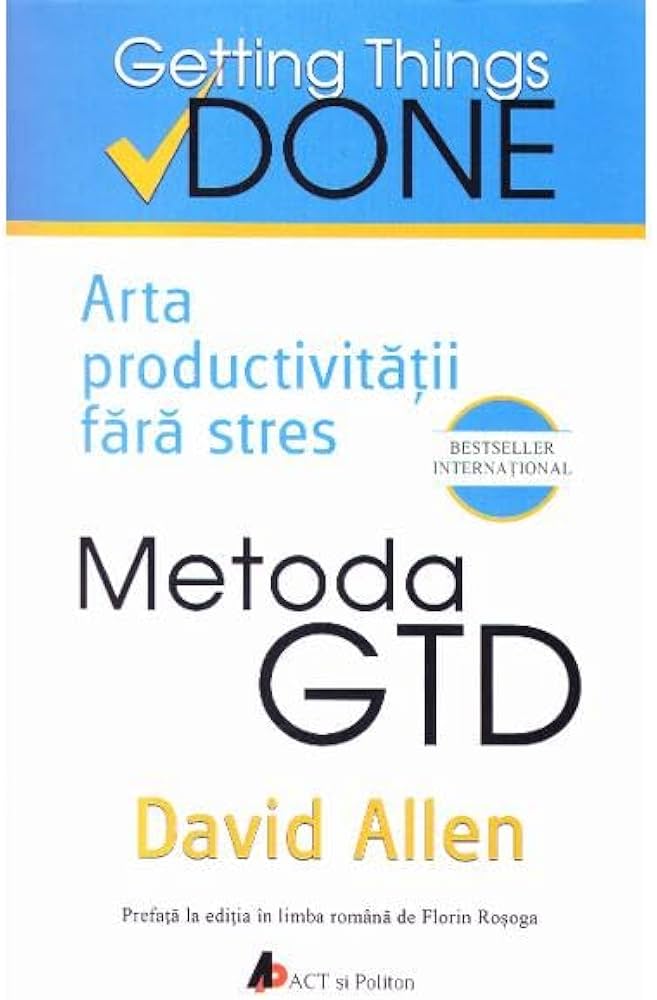GTD Method: How to Effectively Manage Your Time and Tasks with the Help of David Allen
Introduction to the GTD Method
The GTD (Getting Things Done) Method was created by David Allen as an efficient solution for managing time and tasks in everyday life. This innovative approach focuses on freeing the mind from untracked tasks and on the efficient organization of activities, which helps to boost productivity. The basic concept of the GTD method is based on the idea that, in order to function optimally, individuals must have a clear system to organize their tasks, thus allowing them to concentrate on what is truly important.
The fundamental principles of GTD are structured into five essential steps: capturing, clarifying, organizing, reflecting, and engaging in action. Capturing refers to gathering all tasks, ideas, and projects in one place to relieve the mental burden of forgetting. Clarifying involves analyzing this information to determine what actions need to be taken. Organizing focuses on placing these tasks into systems that facilitate their management, while reflecting allows for periodic review to ensure that the system remains effective. Finally, action is the stage in which the planned activities are actually carried out.
The impact of the GTD method on time management and productivity has been significant, with numerous followers around the world. Users of this method have reported a reduction in stress and an increase in efficiency, due to the ability to approach tasks in a more organized and methodical manner. In conclusion, the GTD method provides a strong framework for anyone who wishes to improve the way they manage their tasks and time, thereby facilitating a more balanced and productive lifestyle.

Fundamental Principles of the GTD Method
Developed by David Allen, the GTD method offers an efficient framework for managing time and tasks, based on five fundamental stages: collection, processing, organization, review, and action. Each of these stages contributes to better work management and a reduction in the stress caused by numerous responsibilities.
The first stage, collection, involves gathering all tasks, ideas, and commitments in one place, known as the “inbox.” This inbox can be a journal, an application, or any other tool that facilitates the capturing of thoughts. For example, when an idea for a future project arises, it must be noted immediately to prevent it from being forgotten.
The next stage, processing, entails analyzing each item from the inbox to determine what should be done with it. This is the moment when you decide whether the task requires immediate action, needs delegation, or can be postponed. The essential categories A, B, C can help in this process.
Following that, the organization stage refers to classifying the processed tasks into specific categories, such as projects, recurring responsibilities, or waiting lists. This step is crucial for obtaining an overview of your commitments.
Next, the review is necessary to keep the system functional and up-to-date. A weekly review of the lists allows you to identify priority tasks and adjust plans according to priorities.
Finally, the last stage, action, involves putting the planned tasks into practice. The decisions made in the previous stages are realized through carrying out the established activities, taking into account the available resources and allotted time.
Collecting Information and Tasks
One of the main pillars of the GTD (Getting Things Done) method proposed by David Allen is the process of collecting information and tasks. This initial step allows users to gather ideas, tasks, and mental commitments into an efficient system, thus reducing the feeling of being overwhelmed. Collection techniques are essential to ensure a clear management of time, allowing individuals to prioritize their activities and focus on those that are truly important.
To collect the information, it is important to have a well-defined recording system. This can be achieved through various tools that facilitate the process, such as note-taking apps or task lists. For instance, applications such as Evernote or Todoist allow users to quickly gather information, create priority lists, and manage tasks in an organized manner. Additionally, a simple notebook or planner can be a useful tool, ensuring that all thoughts are recorded without being lost in the daily mental chaos.
Another particularly important aspect is the timing and method of collecting information. Allen suggests the use of a constant “capture point,” a place where any information that crosses the mind can be gathered. This can be a mobile application, an email, or even a simple memo on the desk. In this way, users can avoid the frustration that arises when they forget an idea or an important task. Sustained and consistent collection allows for a more efficient time management process, contributing to the creation of a continuous and orderly workflow.
Processing Tasks – From Idea to Action
In the GTD (Getting Things Done) method developed by David Allen, processing tasks plays a crucial role in efficient time and task management. This stage comes after tasks have been gathered and requires an appropriate evaluation to determine the next steps. Effective task processing involves transforming unclear ideas into clear and achievable actions. Each task must be critically analyzed to decide whether it needs to be delegated, postponed, or acted upon immediately.
A key criterion in this process is the clarification of the task. It is important to understand exactly what a task entails and what steps are necessary to complete it. For example, in the case of a task that can be completed quickly, such as sending an email, it is recommended to act immediately. In contrast, if the task involves greater effort or requires additional resources, it is essential to decide whether it can be delegated to someone else or postponed for a later time.
When these decisions are made, it is useful to evaluate each task based on its importance and urgency. Using an evaluation matrix can help classify tasks according to these criteria and prioritize them. It is essential that task processing becomes an integral part of the time management routine to ensure an efficient workflow and to avoid the pile-up of unresolved tasks.
Organizing Tasks into a Coherent System
In the process of managing time and tasks, organizing them into a coherent system is essential for maximizing efficiency. The application of the GTD (Getting Things Done) methodology developed by David Allen focuses on categorizing tasks and setting priorities to facilitate better management.
One of the first steps in organizing tasks is creating task lists. These lists allow the individual to visualize everything that needs to be done, segmenting the tasks according to various criteria, such as urgency or field of activity. It is important that these lists are constantly updated, ensuring that they reflect the tasks in progress. Additionally, setting up a separate list for high-priority tasks can help concentrate resources on activities that require immediate attention.
Using a calendar is another effective method of task organization. By scheduling activities by days or weeks, the individual can avoid overlapping tasks and allocate time for each activity. This approach helps not only to maintain a clear structure but also to meet deadlines.
In the digital age, dedicated applications for managing time and tasks can offer personalized solutions. These allow users to organize tasks, set alerts, and collaborate with others by sharing task lists. There are multiple applications available, each offering specific functionalities that can be adapted to individual needs. By integrating these tools, a coherent time management system is not only possible but also accessible, thus contributing to enhanced productivity.
Regular Task Review
One of the most essential practices in the GTD (Getting Things Done) methodology developed by David Allen is the regular review of tasks. This activity not only allows for tracking progress but also for adjusting and reorganizing tasks to ensure maximum efficiency in managing time and resources. The weekly review is a key aspect that helps maintain direction and clarity regarding priorities.
Within this process, it is recommended to analyze each completed task, reflect on the challenges encountered, and assess the results obtained. This is an opportune moment to determine whether the established objectives have been met and whether adjustments are necessary. It is also advisable to review all ongoing projects to check if they are aligned with long-term goals. Therefore, consider asking relevant questions such as: “Did I meet the deadlines?” or “Are there tasks that are no longer relevant?”
In addition to progress analyses, the weekly review should include an update of the action plan. This may involve redistributing tasks according to priorities, updating the calendar, or setting new deadlines for delayed tasks. Keeping a journal of reviewed tasks can provide a clear picture of what is working well and which strategies require improvement. Implementing such a routine not only enhances efficiency but also contributes to reducing the stress associated with time and task management.
Action Techniques within the GTD Method
Within the Getting Things Done (GTD) method developed by David Allen, action techniques play an essential role in efficient time and task management. Among the most popular strategies is the Pomodoro Method, which combines focused work intervals with short breaks. This technique promotes better concentration and productivity, allowing users to be more engaged in their tasks. Implementing this method into the daily routine can help avoid burnout and maintain a constant work flow.
In addition to the Pomodoro Method, the strategy of working in time blocks is another effective approach. This involves dedicating well-defined time intervals for important tasks, without allowing external distractions. By organizing activities into specific work sessions, maximum efficiency can be achieved, thereby facilitating the management of complex tasks. This technique can be adapted according to one’s personal working style, either by allocating fixed hours during the day or by dedicating certain days to particular types of tasks.
Using mind techniques is also crucial for maintaining focus on the essential tasks. These methods, such as visualizing progress or setting clear objectives, help maintain motivation and organize thoughts. By integrating these strategies into the GTD method, users can develop a personalized organizational system that meets their specific needs. Thus, a conducive environment is created for accomplishing tasks, contributing to a more organized and productive professional life.
The Benefits of Implementing the GTD Method
The Getting Things Done (GTD) method, developed by David Allen, has gained international recognition due to its ability to transform the way individuals manage their tasks and time. By adopting this method, users frequently notice a significant increase in productivity. GTD provides a clear structure that allows users to organize their thoughts and tasks through well-defined lists and workflows.
One of the major benefits of implementing the GTD method is the reduction in stress. When tasks are archived efficiently and ingeniously, the individual is no longer overwhelmed by pending thoughts. This approach reduces the feeling of pressure and provides the user with a freer mind to focus on current activities. Furthermore, studies show that people who use the GTD method report an overall improved sense of well-being and lower levels of anxiety, thanks to the clarity and organization of their thoughts.
Another important advantage is the improvement in the balance between professional and personal life. The GTD method encourages users to set priorities and allocate specific time for each area of their lives, which contributes to better time management. Thus, individuals can have more time for family, hobbies, and relaxation without sacrificing workplace efficiency.
Testimonials from users confirm the positive impact of the GTD method. For example, a project manager noted a 30% increase in efficiency by implementing GTD, which also led to improved relationships with colleagues. Other case studies demonstrate similar outcomes for professionals in various fields; implementing this method allowed them to better organize their daily tasks, thereby enhancing not only productivity but also the quality of their personal lives. Therefore, GTD proves to be an essential method for anyone who wishes to efficiently manage their time and daily tasks.
Conclusions and Next Steps for Implementing GTD
The GTD (Getting Things Done) method developed by David Allen offers an efficient framework for managing time and tasks, facilitating better organization and focus. By structuring activities into clear steps and using specific tools, this method helps reduce stress and boosts productivity. Implementing GTD requires a commitment to adapting the techniques to one’s personal working style, which can considerably improve the management of daily tasks.
Starting the implementation process of the GTD method can be achieved through several essential steps. First, it is crucial to collect all tasks, ideas, and projects in a single recording system, whether it is a notebook, a digital application, or a hybrid tool. This simple act of collection helps clear the mind and reduces the risk of forgetting important tasks.
The next step consists of processing this information. It is important to decide what should be done with each collected item, whether it involves delegating a task, planning it for a later time, or completely eliminating it if it is no longer relevant. Also, using lists such as “Immediate Actions” or “Projects” can help maintain a clear overview of current activities.
Finally, it is recommended to periodically review these lists to assess progress. This not only ensures that all tasks are up-to-date but also provides an opportunity to reflect on the effectiveness of the GTD method in your life. For a deeper understanding of the discussed concepts, readers are encouraged to consult the materials offered by David Allen, such as his book “Getting Things Done”, as well as various online resources and training courses available on this topic.
How Was the GTD Method Born and What are the Basic Principles That Make It So Effective?
The GTD (Getting Things Done) method was created by David Allen as a response to the acute need to organize tasks in a structured and efficient manner. The basic principle is that the human mind works better when it is not burdened by the “mental list” of everything that needs to be done. To achieve an optimal level of productivity, the GTD method proposes five key stages:
- Capturing all tasks, ideas, and commitments in one place (inbox).
- Clarifying them by establishing the necessary action steps.
- Organizing the information into well-defined categories and lists.
- Reflecting periodically to keep the system updated.
- Acting according to the established tasks and identified priorities.
This structure allows the mind to be freed from the constant worry about what still needs to be done, thereby facilitating focus on immediate actions and the achievement of essential objectives.
Why is Centralized Task Collection Important and How Does This Process Help Reduce Stress?
Centralized collection of tasks is essential because it spares us the stress generated by the fear of forgetting something or losing sight of important aspects. When all information, ideas, and commitments are in one place—whether a journal, a mobile app, or a planner—the mind no longer needs to store those internal “reminders.” Consequently, the constant pressure to remember tasks disappears, and attention can be directed towards current activities, which leads to a significant reduction in stress and an increase in productivity.
What is the Role of Processing in the GTD Method and How Can It Be Applied in Daily Life?
Processing is responsible for transforming any collected idea, information, or task into a concrete action or a clear decision. In practice, this means regularly going through all items in the inbox and establishing the next steps. It is clarified whether a task can be done immediately, needs to be delegated, or can be postponed. Additionally, tasks that do not require further action are identified and can be archived or eliminated. Task management applications or simply using a calendar can facilitate the process, ensuring efficient sorting of all responsibilities.
How are Tasks Practically Organized Within the GTD Method and Why is Their Segmentation Useful?
Organizing tasks is a crucial step that involves fitting each entry into a specific category or list. For example, we can have separate lists for:
- Active projects (activities involving multiple steps).
- Tasks that can be performed immediately.
- Delegated tasks (for which a response is awaited).
- Ideas and future projects (long-term plans).
Segmenting tasks prevents clutter and provides clarity. Thus, instead of facing an enormous list of activities, we have well-defined lists, each with its own priorities. When we know exactly where to look and how to classify tasks, decisions are made faster, time is planned better, and a more coherent overview of all responsibilities is achieved.
What Does the Periodic Review of the GTD System Consist Of and What Are Its Benefits for Productivity?
A systematic review, usually weekly, involves going over all the lists and collected materials. In this way, progress is checked, current priorities are analyzed to see if they are still valid, and new or existing tasks are updated. This routine offers several benefits:
- It keeps the work system relevant and up-to-date.
- It allows for the early identification of bottlenecks or delays.
- It creates a sense of control and prevents the buildup of what we call “mental clutter.”
- It facilitates the adjustment of objectives and priorities to remain aligned with actual needs.
With this approach, the GTD method becomes a flexible tool, ready to respond to any changes or new challenges.
What Action Techniques Can Be Integrated Into the GTD Method to Enhance Focus and Prevent Burnout?
In the GTD method, every action is based on task clarity and setting priorities. To improve efficiency, additional recognized techniques can be integrated:
- The Pomodoro Method: This involves alternating focused work intervals (25 minutes) with short breaks (5 minutes), which prevents mental exhaustion.
- Time-blocking: This involves reserving specific time intervals in the calendar exclusively for important tasks, without interruptions and with the phone or notifications on silent.
- Mindfulness techniques: These include short breathing exercises or meditation to help relax the mind before starting a complex task.
These strategies can be adapted to each work style, providing additional structure and supporting a healthy work rhythm.
How Does the GTD Method Contribute to Stress Reduction and the Improvement of Work-Life Balance?
The GTD method encourages a balanced approach to responsibilities. Once tasks are clearly defined, ordered, and integrated into a coherent system, the uncertainty and pressure of retaining everything that needs to be done disappear. The individual gains an overall vision and can allocate specific time for work, family, hobbies, and rest. Additionally, because urgent and important tasks are managed in an organized way, the excessive accumulation of activities and deadlines is prevented, which keeps the stress level at a functional minimum and improves the overall quality of life.
What Practical Benefits Have People Reported After Implementing the GTD Method in Their Daily Activities?
Users of the GTD method often mention a significant increase in productivity due to clear organization and efficient prioritization of tasks. Many of them notice a reduction in anxiety and the feeling of being overwhelmed, as there is no longer a need to mentally retain all projects and deadlines. In addition to these aspects, better team collaboration is reported, since tasks are communicated and distributed with more precision. Ultimately, a mind free from stress allows individuals to be more creative and make decisions with greater clarity.
How Can One Start Implementing the GTD Method if They Have Never Used an Organization System Before?
The first step is to set up an “inbox” or collection space where all tasks, ideas, and notes are gathered. Then, in a dedicated session, review all the collected items to clarify and organize them. Distinct lists can be created, such as “Active Projects” and “Immediate Tasks,” providing an overall picture of future activities. The key lies in reviewing this system daily and weekly, to ensure you do not stray from the plan. As you become more familiar with the process, you can add additional techniques—such as the Pomodoro Method or time-blocking—to improve your work rhythm.
What Are the Most Important Steps to Follow to Keep the GTD Method Functional in the Long Term?
Maintaining GTD effectively in the long term depends on a few essential practices:
- Constantly updating the system: everything new (tasks, ideas) must be immediately entered into the “inbox” and processed according to the rules.
- Periodic review: a weekly examination of lists and projects prevents the accumulation of disorganized tasks and keeps priorities clear.
- Adapting the methodology to personal needs: each person has their own working style, and GTD can be adapted according to individual preferences and activities.
- Disciplined practice: even if the initial enthusiasm is high, the constant discipline of noting tasks and reviewing progress makes the difference between an efficient system and one that is abandoned.
By following these steps, the GTD method can become a reliable ally in time management, supporting an orderly and productive lifestyle.








